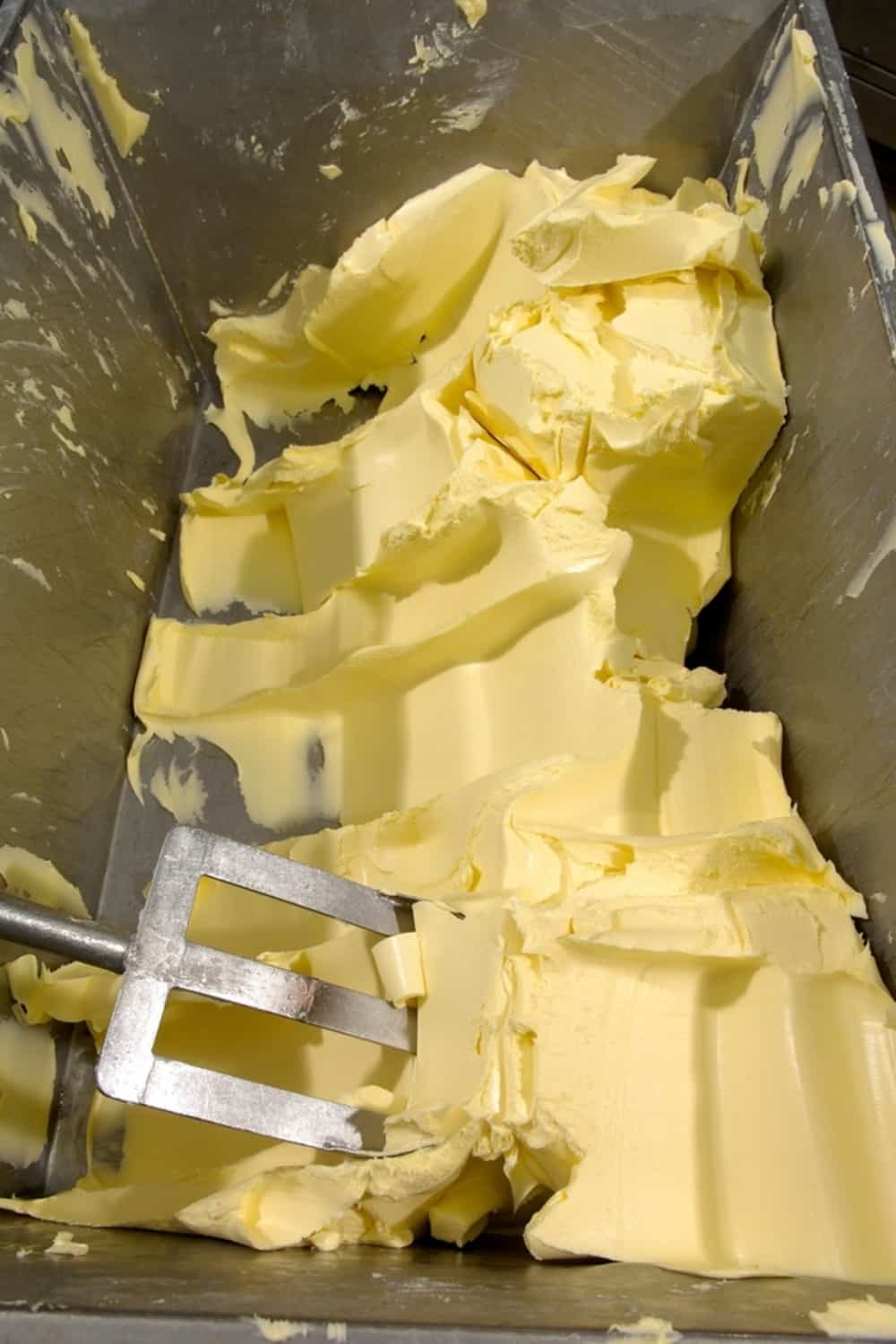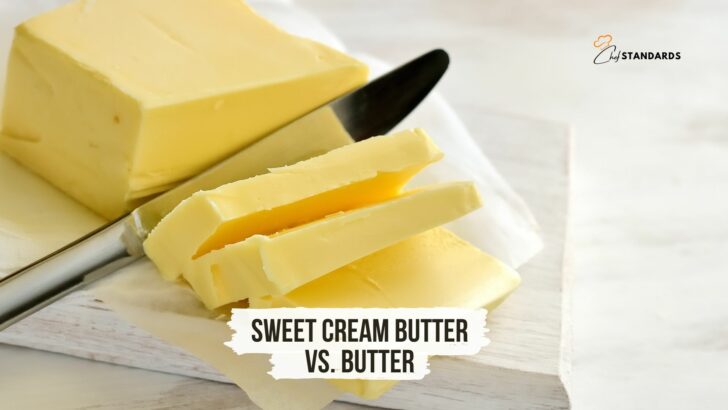Who doesn’t use butter? This wonderful ingredient adds richness and depth to everything from flaky croissants to silky sauces. Recent studies also suggest that butter can be quite beneficial for health if used in moderation.
It is a truly amazing ingredient that almost has it all. But did you know that not all butter is created equal? Although all types of butter are very similar, there are some slight differences that need to be discussed.
The most popular type of butter in the US is sweet cream butter. However, “regular” butter or just “butter” that is more famous in Europe is not exactly the same.
So what are the main differences between sweet cream butter and butter? Well, let’s take a look.
What Is Sweet Cream Butter?
As already stated in the introduction, sweet cream butter can mostly be found in the US where it is very popular. Because of that, it is sometimes referred to as American butter or American-style butter.
It is a type of butter made from fresh, sweet cream that has not been cultured or soured.
The cream used in sweet cream butter production is typically pasteurized and then allowed to rest for a short period before it is churned.
During the churning process, the fat in the cream is agitated until it separates from the liquid (buttermilk), resulting in solid butter.
When it comes to the word “sweet”, there is a lot of confusion because many people think that sugar is added, but that is not the case.
In fact, it is used for distinguishing sweet cream butter from sour cream butter, which are, as the name suggests, not sweet but rather sour.
One more thing, there are two main types of sweet cream butter, salted and unsalted.
Unsalted sweet cream butter is slightly more popular with cooks and bakers since using unsalted butter allows the chef to better control the amount of salt in a recipe.
What About “Regular” Butter?

The real term to use for regular butter is actually “cultured butter”. It is a type of butter made from cream that has been cultured or fermented prior to churning.
To make cultured butter, fresh cream is typically left to rest for several hours to allow natural bacteria in the cream to ferment the lactose and other sugars.
The cream is then churned until the fat separates from the liquid, resulting in solid butter. The butter is then washed and kneaded to remove any remaining liquid, resulting in a more concentrated butter with a rich, creamy texture.
Cultured butter is often made with cream that has not been pasteurized or homogenized, which can impact the flavor and texture of the final product.
Due to the presence of beta-carotene in the cream, the butter typically has a more yellow color than sweet cream butter.
This type of butter is also known as “European style butter” due to its high popularity in Europe, i.e. in European style baking and cooking.
As with sweet cream butter, you can also find salted and unsalted versions of cultured butter.
9 Main Differences Between Sweet Cream Butter And Butter
Now you have some general information about both sweet cream butter and regular butter and it is possible to spot some of the main differences already.
However, below I presented the more detailed comparison and I am sure that it will help you in better distinguishing the two, especially in terms of your future cooking and baking endeavors.
1. Ingredients

There are slight differences between sweet cream butter and regular butter in terms of ingredients used for making.
Sweet cream butter contains pasteurized cream, water, milk solids, and sometimes salt (depending whether it is salted or unsalted). Regular butter, on the other hand, uses a fermented milk or added cultures to the milk.
The amount of water is also less in regular butter and it can contain salt as well.
2. Fat Content
When it comes to fat content, there is also a little difference between the two types of butter.
However, you have to know that sweet cream butter, typically found in the US, must contain at least 80 percent butterfat from cow’s milk and more than 16 percent water.
This ratio is monitored by the USDA (United States Department of Agriculture).
When it comes to cultured butter, although the exact amount of fat varies from brand to brand, it typically contains a slightly higher amount of fat compared to sweet cream butter.
3. Smoke Point
There is no significant difference between sweet cream butter and cultured butter in terms of smoke point.
The smoke point of butter is determined by the temperature at which the milk solids begin to burn and smoke, which is typically around 350-375°F (177-191°C) for both types of butter.
However, the smoke point in sweet cream butter is typically slightly lower than in regular butter.
This means regular butter can be used at a higher heat without the risk of burning. This is great if using butter to cook on the stove.
Additionally, you have to know that the smoke point of butter in general can vary depending on the specific brand, type, and method of production.
For example, butter that has been clarified (i.e., where the milk solids have been removed) has a higher smoke point, as the milk solids are what burn and smoke at high temperatures. So take that into account as well.
4. Churning Process

Both types of butter go through the churning process, but the difference lies in the duration.
The churning process for sweet cream butter typically involves separating the cream from the milk, then agitating the cream until the butterfat solidifies and separates from the buttermilk.
This can be done using a churn or a mixer and takes anywhere from a few minutes to several hours.
For cultured butter, on the other hand, the cream is first inoculated with lactic acid bacteria and allowed to ferment for several hours or overnight.
Only then, the fermented cream is churned to separate the butterfat from the buttermilk, in the same way as sweet cream butter.
5. Texture And Flavor
Due to the previously explained different processes, the flavor and texture of sweet cream butter and regular butter are also slightly different.
First, sweet cream butter doesn’t go through the fermentation process. Because of that, it has a more neutral flavor with hints of natural sweetness from just pasteurized cream.
To be clear, that is not the sweetness of cookie butter flavor, but the hints are there, and that is important.
When it comes to texture, sweet cream butter has a somewhat smooth, creamy texture.
Cultured butter, on the other hand, is made from cream that has been allowed to ferment before churning.
This fermentation process gives regular butter a tangy, slightly sour flavor and a denser, more complex texture.
What’s more, the bacteria in the cream produce lactic acid, which changes the pH of the butter, giving it a slightly acidic taste and a firmer texture.
6. Nutritional Info
There has been a lot of discussion recently about the effects of butter on overall health. In the past, butter was seen as a bad thing, but was recently reestablished as a healthy food item, if consumed in moderation.
It is therefore not out of hand to briefly discuss the nutritional value of both types of butter.
As you already know, regular butter has a slightly higher amount of fat, i.e. 12 grams of fat and 110 calories per tablespoon, and around 86 percent butterfat.
Those are mainly saturated fats in both types of butter. However, the fat composition of cultured butter is slightly different because of the fermentation process, which can result in a higher proportion of monounsaturated and polyunsaturated fats.
When it comes to nutrient composition, all types of butter are a good source of fat-soluble vitamins, such as vitamin A and vitamin K2, as well as conjugated linoleic acid (CLA).
Since sweet cream butter is generally made from pasteurized cream that has not been fermented, it may have a slightly higher vitamins and minerals content compared to cultured butter.
Finally, cultured butter contains live bacteria cultures, which may have potential health benefits for the gut microbiome. These bacteria can help to improve digestion, boost the immune system, and reduce inflammation.
Also, the fermentation in cultured butter can increase the bioavailability of certain nutrients, such as vitamin K2 and CLA.
Because of these healthy bacteria, I would give a slight advantage to cultured butter when it comes to health benefits.
7. Price Comparison

The cost of sweet cream butter and cultured butter can vary depending on a variety of factors, such as the production method, the brand, and the region.
In general, cultured butter tends to be more expensive than sweet cream butter, primarily due to the additional time and resources required to make it.
Sweet cream butter, on the other hand, is made from fresh cream that has not been fermented. The production process is typically simpler and requires fewer resources, which can make it less expensive than cultured butter.
However, it’s important to note that the cost difference between sweet cream butter and cultured butter can vary depending on the brand and the region.
Some high-end sweet cream butter made from high-quality cream may be more expensive than lower-quality cultured butter.
Additionally, the price of butter can be affected by factors such as supply and demand, production costs, and transportation costs.
8. Storage And Shelf Life
Sweet cream butter and cultured butter have slightly different shelf lives. The main reason for this is the fact that cultured butter is made by fermenting, making it more sensitive to spoilage.
The bacteria in the butter can continue to ferment and cause the butter to spoil faster.
It should therefore be kept in the refrigerator and consumed within a week or two of purchase. It can also be frozen for up to 3 months, but the texture may change slightly after thawing.
Sweet cream butter, on the other hand, can be stored in the refrigerator for up to 3 months or in the freezer for up to 6 months.
It’s important to keep sweet cream butter tightly wrapped or in an airtight container to prevent it from absorbing odors from other foods in the fridge or freezer.
Finally, both types of butter should be stored away from light, heat, and moisture to prevent spoilage.
9. Main Uses
Although they can be used interchangeably, there are some recipes where one type of butter is preferable to the other and vice versa.
First, since cultured butter has a tangier flavor due to the fermentation process, it can be more suitable for dishes like sauces, pastries, and bread.
Sweet cream butter has a milder flavor and it works well in recipes where a neutral taste is desired.
Due to its higher fat content, cultured butter is also slightly creamier, which makes it a good choice for baking recipes, such as cakes, cookies, and pastries.
Sweet cream butter has a firmer texture and can be easier to work with for certain applications, such as making pie crusts.
Finally, acidity also plays a role when choosing the right butter for your recipe.
Namely, cultured butter has a higher level of acidity, and that can make it a good choice for recipes that require a touch of it, such as crème fraîche or lemon curd, for example.
You can also use it to make butter chicken or tikka masala, two popular Indian types of dishes.
Sweet cream butter, on the other hand, can be a better choice for recipes where acidity is not desired.
You can use both types of butter to make delicious benihana garlic butter, but it has to be unsalted.


